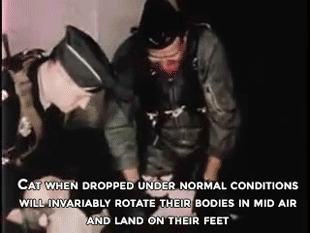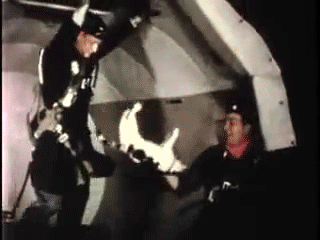For More Posts Like These, Go To @mypsychology



For more posts like these, go to @mypsychology
More Posts from Science-is-magical and Others

Have you ever seen a Lybia crab? Often called boxer crabs, or pom-pom crabs, these tiny crustaceans are easily identified by a unique behavior: they hold anemones on their claws to defend themselves from predators, keeping the anemones small enough to wield by limiting their food intake. But how do they get the anemones in the first place? Researchers think they have an answer: by stealing one from another crab, and then splitting it in half to create two identical clones—one for each claw.
Two graduate students, Yisrael Schnytzer and Yaniv Giman, set out to discover how the Lybia crabs acquire their anemones. They spent years observing and collecting crabs (Lybia leptochelis, specifically) from the Red Sea. Given that Lybia crabs are exceptionally well-camouflaged and only a few centimeters across, this was no easy task, but they managed to observe or collect more than 100 individuals.
Every specimen Schnytzer and Giman found was in possession of a pair of anemones, and each anemone belonged to the genus Alicia. Interestingly, the anemones themselves were not found living by themselves; they were only found already living on the claws of Lybia crabs. The researchers decided to study some of the crabs in a laboratory, to see if more observation would solve the mystery of how they acquired their anemones to begin with.
In the lab, the researchers conducted several experiments, the first of which was to take one anemone away from a crab. When left with just one anemone, the crab solved the problem by splitting the remaining anemone into two. The two halves of the anemone would then regenerate into two identical clones, one for each claw, over the course of several days.
The second experiment involved removing both anemones from one crab and placing it in a tank with a crab that still had both its anemones. The result: the two crabs would fight, with the anemone-less crab usually succeeding in stealing one anemone from the other crab. These fights did not tend to result in injuries to the crabs themselves, and once each crab was in possession of one anemone, both crabs would split their anemone into halves to create a pair of clones.
In addition to these experiments, Schnytzer and Giman examined the genes of the anemones found on the wild crabs. Every crab collected from the wild was holding a pair of identical clones. This might mean that anemone theft is rampant among Lybia crabs in the Red Sea, and that it might be the main way that these crabs acquire their anemones.
At any rate, it is clear that the crabs are frequently splitting anemones in two, inducing asexual reproduction in another species and potentially limiting that species’ genetic diversity in the process—a rarity outside the human world.
Based on materials provided by PeerJ and ScienceDaily
Journal reference: Yisrael Schnytzer, Yaniv Giman, Ilan Karplus, Yair Achituv. Boxer crabs induce asexual reproduction of their associated sea anemones by splitting and intraspecific theft. PeerJ, 2017; 5: e2954 DOI: 10.7717/peerj.2954
Image credit: Yisrael Schnytzer
Submitted by volk-morya
Listening To Music Releases Dopamine In The Brain
Have you ever been listening to a piece of music and experienced intense pleasure, even chills? Valorie Salimpoor and team (2010) conducted research that shows that listening to music can release the neurotransmitter dopamine.
A wide range of music — The researchers used PET (positron emission tomography) scans, fMRI, and psychophysiological measures such as heart rate to measure reactions while people listened to music. The participants provided music that they said gave them intense pleasure and chills. The range of music varied, from classical, folk, jazz, elecronica, rock pop, tango, and more.
Keep reading
Flying to New Heights With the Magnetospheric Multiscale Mission
A mission studying Earth’s magnetic field by flying four identical spacecraft is headed into new territory.

The Magnetospheric Multiscale mission, or MMS, has been studying the magnetic field on the side of Earth facing the sun, the day side – but now we’re focusing on something else. On February 9, MMS started the three-month-long process of shifting to a new orbit.

One key thing MMS studies is magnetic reconnection – a process that occurs when magnetic fields collide and re-align explosively into new positions. The new orbit will allow MMS to study reconnection on the night side of the Earth, farther from the sun.

Magnetic reconnection on the night side of Earth is thought to be responsible for causing the northern and southern lights.

To study the interesting regions of Earth’s magnetic field on the night side, the four MMS spacecraft are being boosted into an orbit that takes them farther from Earth than ever before. Once it reaches its final orbit, MMS will shatter its previous Guinness World Record for highest altitude fix of a GPS.
To save on fuel, the orbit is slowly adjusted over many weeks. The boost to take each spacecraft to its final orbit will happen during the first week of April.

On April 19, each spacecraft will be boosted again to raise its closest approach to Earth, called perigee. Without this step, the spacecraft would be way too close for comfort – and would actually reenter Earth’s atmosphere next winter!

The four MMS spacecraft usually fly really close together – only four miles between them – in a special pyramid formation called a tetrahedral, which allows us to examine the magnetic environment in three dimensions.

But during orbit adjustments, the pyramid shape is broken up to make sure the spacecraft have plenty of room to maneuver. Once MMS reaches its new orbit in May, the spacecraft will be realigned into their tetrahedral formation and ready to do more 3D magnetic science.

Learn more about MMS and find out what it’s like to fly a spacecraft.


It’s officially starry scholastic month!
Planet X starts off with a quick science fact!
Planet X’s first lesson will be posted tonight!
Today’s starry Fact: Niku
http://www.popularmechanics.com/space/deep-space/a22293/niku-weird-object-beyond-neptune/
which scientist should you fight
geologist: will throw copious amounts of rocks at you. not recommended unless you can also throw equal amounts of rocks back
botanist: knows 1001 ways to poison you. probably shouldn't fight
zoologist: knows 1001 animals that can kill you. probably shouldn't fight either
entomologist: spiders. enough said.
physiologist: they know too much about the human body and how to cause optimal pain with minimal damage. not safe.
geneticist: will unleash their army of mutated fruit flies at you. can be either good or bad thing, depending on your preference for flies with legs growing out of their eyes
immunologist: they have perfected the t-cell inspired technique of "death by neglect". if you fight them you will die in the saddest way possible
microbiologist: please don't fight someone who is already pissed about antibiotic resistance and can identify bacteria based solely on their smell
climatologist: will choose the battlefield as somewhere in the path of a category 5 hurricane and then leave you to die. do not fight please
environmental scientist: they can control the entire world do you really want to fight them
chemist: have you seen breaking bad? no, do not fight them. do NOT
physicist: will kill you with math. not the best way to go
herpetologist: can probably speak parseltongue and know just which frogs are best at taking over your habitat. only fight if you live in antarctica
cancer biologist: has immediate access to at least 5 different tumor cell lines and knows exactly where to inject them in your heart to cause metastases. don't even look them in the eye
marine biologist: is a real life aquaman. will lure you with cute river otters and then finish you off with some terrifying deep sea creature. better to just stay home and never leave
psychologist: is basically a mind reader. will drown you in your deepest darkest fears. 10/10 do not recommend to fight
molecular biologist: will kill you organelle by organelle. you will die a slow and painful death while covered in budding yeast
statistician: their power is always over 80%, and they will quickly punt you in the path of a normal distribution even before you can yell "Wilcoxon!"
archaeologist: can use a trowel 59 different ways, and only 9 are for digging. one can only guess the other 50, so may be advisable to stay far away
astronomer: will launch you into space and send you to a planet so inhospitable not even matt damon can make it back this time
pharmacologist: why would you ever fight someone who knows all about drugs. why
computer scientist: they know the perfect algorithm for death. do not fight, even with a firewall
linguist: no matter where you are, they can talk about you behind your back in the native tongue. do you really want death by humiliation. do you
dinosaurologist: are you kidding me?? the answer is no
sociologist: yea

To help me refer my chemistry resources to students who seek help, I made a list of all the chemistry master posts I created in the past. Please enjoy and don’t forget to message me if any other chemistry questions arise or if you found anything in this post helpful!
General Chemistry 101 // Contains helpful websites, practice tests, study guides, and tips.
Steps to Balancing Chemical Equations // A 10 step guide to solving unbalanced chemical equations. Practice problems are provided at the end!
Ideal Gas Laws // A little introduction to the history of ideal gas laws and a breakdown of each equation. Also, it contains resources to learn more about them, practice problems, and a personal tip on how I tackle problems!
Electrochemistry Q // I got asked about galvanic cells. With my best attempt, I answered with basic definitions and posted some good websites! However, my knowledge grew about this topic so ask any further questions in my ask.
How I Survived Organic Chemistry // I provide tips on how to study and prepare for organic chemistry.
Organic Chemistry Synthesis Q // My old organic chemistry professor gave us amazing roadmaps of the syntheses we learned in organic chemistry I (Alcohol, alkyne, alkene, epoxide).
Emil Fisher // A short history post about Emil Fisher and his work with fisher projections. Linked are some practice problems on fisher projections which are my favorite!!
NMR // Another short history post but about nuclear magnetic resonance spectroscopy. Like before, practice problems are linked in the description!
A Master Post of Chemistry Resources // My favorite master post of all time. It contains websites with information and practice problems for every subject in chemistry.
How To: Pass and Prepare for A Chemistry Exam // Chemistry exams can be pretty stressful but they don’t have to be! :-)
Tips for Organization // I talk about how to organize your chemistry notes and binders.
Pursuing A Chemistry Degree Q // Just a little something for students who want to major in chemistry but don’t know if they should do a B.A. or B.S. (Valid for the USA, not sure if other countries do the B.A./B.S. system).
Hopefully, I’ll be updating this with more resources in the future! Don’t forget to check out my “Dummies Guide to Physics”! Another good master post that isn’t related to chemistry.
- TheChemistryNerd


Olinguito
On Tuesday, Bill Stanley grabbed my arm and pulled me into a side hallway as we were walking towards the mammal collections on the third floor. He looked around suspiciously before leaning in, and in a hushed tone he said
there’s a new raccoon.
What do you mean?
There’s a new raccoon. You can’t tell anyone. It’s in the pipeline. Going live on Thursday.
Wha- I wasn’t going to-
You can’t tell anyone. Guess where it was discovered?
Oh, geez. I don’t know. Maybe Per-
Here. It was discovered here.
Then he patted my shoulder, winked, and kept walking.
Such was my introduction to the olinguito - and yesterday Bill brought it out to show me. In front of us were two drawers, one with the previously known species and the newly described animals on the right. It was immediately obvious to me that before us were two different animals - the size, color and length of the fur, the size of the ears - but without the previous knowledge that they were not one in the same, would I have seen the same dissimilarities?
This is what sparks me. This is what drives my enthusiasm. In these drawers for sixty years, side-by-side these animals remained, their full potential not realized until a curious researcher took the quiet time to sit down and take a concentrated look at them. It’s the romance of the discovery – it was here all along! – and once you see the striking inconsistencies there comes a feeling of empowerment, the thought that we are the next big discoverers. The thrill of the breakthrough remains attainable, accessible. It’s not beyond our reach or out of grasp - I look forward to seeing what you find next.
-
 franchescaalovee reblogged this · 9 months ago
franchescaalovee reblogged this · 9 months ago -
 theliftisoutoforder reblogged this · 9 months ago
theliftisoutoforder reblogged this · 9 months ago -
 diman0166 liked this · 1 year ago
diman0166 liked this · 1 year ago -
 virginstoner666 reblogged this · 1 year ago
virginstoner666 reblogged this · 1 year ago -
 cadistrecasul liked this · 1 year ago
cadistrecasul liked this · 1 year ago -
 sometimes-a-writer reblogged this · 1 year ago
sometimes-a-writer reblogged this · 1 year ago -
 forpababubb liked this · 1 year ago
forpababubb liked this · 1 year ago -
 annanningxil liked this · 1 year ago
annanningxil liked this · 1 year ago -
 gradaducfi liked this · 1 year ago
gradaducfi liked this · 1 year ago -
 pruplemonkeydishwasher liked this · 2 years ago
pruplemonkeydishwasher liked this · 2 years ago -
 melhorsemsutia liked this · 2 years ago
melhorsemsutia liked this · 2 years ago -
 crumbdiminal liked this · 2 years ago
crumbdiminal liked this · 2 years ago -
 debiilukk reblogged this · 2 years ago
debiilukk reblogged this · 2 years ago -
 sashalasha reblogged this · 2 years ago
sashalasha reblogged this · 2 years ago -
 abtoddler liked this · 2 years ago
abtoddler liked this · 2 years ago





